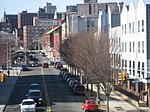Forest Houses
1956 architectureMorrisania, BronxPublic housing in the BronxResidential buildings in the Bronx
The Forest Houses are a housing project in Morrisania, Bronx. The project consists of fifteen buildings, 9, 10 and 14-stories tall with 1,350 apartment units. It covers a 17.72-acre expanse, and is bordered by East 163rd and East 166th Streets, and Trinity and Tinton Avenues. It is owned and managed by New York City Housing Authority (NYCHA).
Excerpt from the Wikipedia article Forest Houses (License: CC BY-SA 3.0, Authors).Forest Houses
Trinity Avenue, New York The Bronx
Geographical coordinates (GPS) Address Nearby Places Show on map
Geographical coordinates (GPS)
| Latitude | Longitude |
|---|---|
| N 40.82504 ° | E -73.90466 ° |
Address
Forest Houses Building 1
Trinity Avenue 1000
10456 New York, The Bronx
New York, United States
Open on Google Maps










